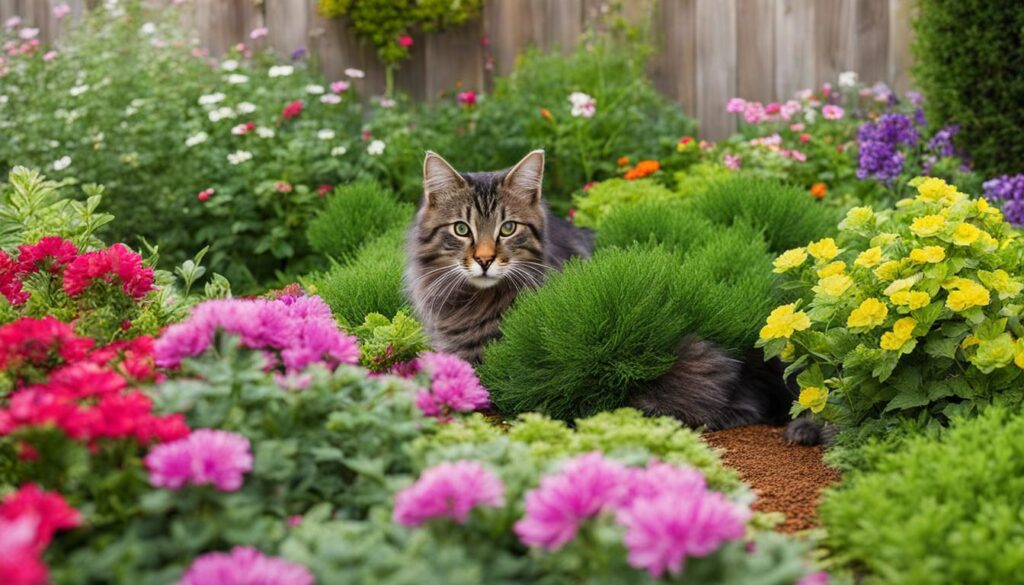If you’re dealing with unwanted cats in your yard, there are effective and humane methods you can use to keep them away. From removing food sources to utilizing scent repellents, there are various strategies you can implement to deter cats from entering your yard and garden.
Key Takeaways
- Removing food sources such as uncovered trash cans and pet food can discourage cats from entering your yard.
- Block access to hiding spots like crawl spaces and decks by using chicken wire or lattice.
- Utilize scent repellents like commercial sprays, citrus peels, or coffee grounds to deter cats.
- Choose cat-repelling plants that are safe for both humans and cats.
- Make potential lounging or digging spots uncomfortable with plastic carpet runners or CatScat mats.
By implementing these humane methods, you can successfully get rid of cats in your yard and maintain a peaceful outdoor space.
Remove Food Sources
Neighborhood cats are often attracted to your yard due to the availability of food sources. It’s important to keep your trash cans covered and secure the lid with bungee cords. Avoid leaving your pet’s food outside as well. If you have bird feeders or birdbaths, consider temporarily stopping their use until the cat situation is under control.
To discourage cats from scavenging through your trash cans, make sure they are securely covered. You can use bungee cords to fasten the lids tightly, preventing cats from accessing the contents. This will help eliminate a potential food source that may be attracting them to your yard.
Another common food source for cats is pet food left outdoors. If you typically leave your pet’s food outside, it’s time to make a change. Bring the food indoors or feed your pet at designated times, ensuring no leftovers are left outside. By removing this food source, cats will be less inclined to frequent your yard.
If you have bird feeders or birdbaths in your yard, you may need to temporarily suspend their use. Although these attract beautiful and interesting visitors, such as birds, they can also be a magnet for cats. By stopping or relocating these features, you can reduce the likelihood of cats being drawn to your yard.
Block Access to Hidey Holes
Cats are known for their love of cozy hidey holes and warm crawl spaces. If you want to deter them from accessing these areas in your yard, installing chicken wire or lattice can be an effective solution. By blocking off their entrances, you prevent cats from using these spaces as their personal hideouts.
When using chicken wire or lattice, it is essential to ensure that no cats or kittens are trapped inside before closing off the hidey holes. Always inspect the area carefully and listen for any meowing sounds to avoid unintentionally harming these curious felines.
By securing crawl spaces and blocking access to hidey holes, you create an environment that is less appealing and welcoming to cats. This simple yet effective method can help successfully keep the unwanted feline visitors out of your yard.
Use Scent Repellents
Cats have a sensitive sense of smell, making scent repellents an effective way to deter them from entering your yard. There are several options available, including:
- Commercial sprays: These sprays are specifically designed to repel cats. Simply spray them around your yard, paying attention to areas where cats frequent.
- Citrus: Cats dislike the smell of citrus fruits. Scatter fresh citrus peels in your yard or use citrus-scented sprays to create areas that cats will want to avoid.
- Coffee grounds: Spread used coffee grounds around your garden or areas where cats like to visit. The strong scent of coffee can be effective in deterring them.
- Tea leaves: Sprinkling tea leaves in your yard can also help repel cats. They dislike the smell and will be less likely to venture into those areas.
- Vinegar: While cats typically don’t like the smell of vinegar, it’s important to avoid spraying it near grass or garden plants, as it can damage them. Instead, focus on spraying it in areas where cats are not welcome.
- Pipe tobacco: Cats dislike the smell of pipe tobacco. Sprinkle it around your yard to create an unpleasant scent for them.
- Essential oils: Certain essential oils, such as lavender or citronella, can be effective in repelling cats. Apply them strategically in areas where cats are unwanted.
- Blood meal: Cats are repelled by the smell of blood. Adding blood meal to the soil of your garden can help deter them.
Remember to consider the specific needs and preferences of cats in your area when using scent repellents. While some cats may be deterred by one scent, others may not be affected. Therefore, it may be necessary to experiment with different scents or a combination of scents to achieve the desired results.
Using scent repellents is just one of the many strategies you can employ to keep cats out of your yard. In the next section, we will explore another approach: filling your garden with cat-repelling plants.
Fill Your Garden with Cat-Repelling Plants
To naturally deter cats from your garden, consider incorporating cat-repelling plants into your landscape. These plants possess scents that felines find unpleasant, helping to keep them at bay. However, it’s essential to be mindful of the potential toxicity associated with certain plant varieties. Some cat-repelling plants can be harmful to cats, as well as humans and other animals. It’s crucial to choose cat-repelling plants that are safe for both you and your feline neighbors.
Examples of non-toxic cat-repelling plants include:
- Rosemary
- Curry plant
- Lemon thyme
These plants not only add a delightful aroma to your garden but also naturally repel cats without causing harm. By strategically planting these cat-friendly options, you can create a pleasant and unwelcoming environment for cats, effectively discouraging them from venturing into your yard.
Make Potential Lounging or Digging Spots Uncomfortable
When it comes to deterring cats from using your flower beds as lounging or digging spots, making these areas uncomfortable is key. There are several options you can consider:
- Plastic Carpet Runners: Place plastic carpet runners with the prickly side up in your flower beds. The uncomfortable texture will discourage cats from settling in these spots.
- CatScat Mats: Another effective solution is to use CatScat mats. These mats have small, harmless spikes that create an uncomfortable surface for cats, preventing them from lounging or digging in your garden.
- Chicken Wire or Plastic Netting: To prevent digging altogether, consider using chicken wire or plastic netting to cover the soil in your flower beds. This barrier will make it difficult for cats to access the soil and indulge in their digging behavior.
- Rough-Edged or Sharp Mulch: You can also deter cats by covering the soil with rough-edged or sharp mulch. The uncomfortable texture will discourage them from digging in the area.
Implementing these methods will help make uncomfortable spots in your garden, ensuring that cats are discouraged from using your flower beds as their lounging or digging areas.
Utilize Ultrasonic Animal Repellers and Motion-Activated Sprinklers
When it comes to keeping cats out of your yard, ultrasonic repellers and motion-activated sprinklers can be highly effective. These innovative devices use advanced technology to deter unwanted feline visitors.
Ultrasonic animal repellers emit high-frequency sounds that irritate cats and other wildlife. The ultrasonic waves are inaudible to humans but are highly unpleasant for cats, effectively encouraging them to stay away. To maximize their effectiveness, place the ultrasonic repellers strategically around the perimeter of your property, ensuring optimal coverage.
Motion-activated sprinklers, on the other hand, startle cats with a sudden jet of water when they enter a designated area. The motion sensor detects the cat’s movement, triggering the sprinkler to activate. This not only deters cats from entering your yard but also provides an entertaining spectacle for you to witness.
Both ultrasonic animal repellers and motion-activated sprinklers offer a non-harmful and humane solution to keep cats away from your yard. These devices work without causing any physical harm, ensuring the well-being of the cats while protecting your property.
By utilizing ultrasonic repellers and motion-activated sprinklers, you can effectively maintain a cat-free zone in your yard. These innovative solutions are ideal for individuals seeking long-term protection against unwanted feline intruders.
Conclusion
By implementing the strategies mentioned in this article, you can effectively get rid of cats in your yard. Remember to use humane methods and take into consideration the unique preferences and behaviors of the cats in your neighborhood. With perseverance and the right approach, you can keep unwanted feline visitors at bay.
Can the same methods be used to deter cats from entering my yard as they are used to keep dogs from pooping in it?
Yes, many of the same tips to deter dog pooping can also help keep cats out of your yard. Installing motion-activated sprinklers, using natural repellents like citrus peels or coffee grounds, and creating physical barriers can all help deter both dogs and cats from entering your yard.
FAQ
How can I remove food sources to keep cats out of my yard?
To remove food sources, make sure to keep your trash cans covered and secure the lids with bungee cords. Also, avoid leaving your pet’s food outside and consider temporarily stopping the use of bird feeders and birdbaths.
How can I block access to hidey holes where cats like to hide?
You can use chicken wire or lattice to block access to crawl spaces and underneath decks, where cats often hide. Before blocking off their entrance, ensure that no cats or kittens are trapped inside.
What scent repellents can I use to deter cats from my yard?
There are various scent repellents you can try, including commercial sprays specifically designed to deter cats, scattering fresh citrus peels or using citrus-scented sprays, spreading used coffee grounds, sprinkling tea leaves, applying vinegar (avoid spraying near grass or garden), spreading pipe tobacco, using essential oils like lavender or citronella, and adding blood meal to the soil.
Are there any cat-repelling plants that are safe for both humans and cats?
Yes, there are non-toxic cat-repelling plants you can choose from, such as rosemary, curry plant, and lemon thyme. It’s important to pick plants that are safe for both humans and cats, as some plants can be toxic to them.
How can I make potential lounging or digging spots uncomfortable for cats?
You can place plastic carpet runners or CatScat mats with spikes in flower beds to make them uncomfortable for cats. Using chicken wire or plastic netting can also prevent cats from digging. Additionally, covering the soil with rough-edged or sharp mulch can make it less appealing for cats to lounge or dig.
Can ultrasonic animal repellers and motion-activated sprinklers deter cats?
Yes, ultrasonic animal repellers emit high-frequency sounds that irritate cats and other wildlife, effectively deterring them from entering your yard. Motion-activated sprinklers startle cats with a jet of water, further discouraging them from coming onto your property.
How can I effectively get rid of cats in my yard?
By implementing the strategies mentioned in this article, including removing food sources, blocking access to hidey holes, using scent repellents, filling your garden with cat-repelling plants, making potential lounging or digging spots uncomfortable, and utilizing ultrasonic animal repellers and motion-activated sprinklers, you can effectively get rid of cats in your yard. Remember to use humane methods and consider the unique preferences and behaviors of the cats in your neighborhood.











